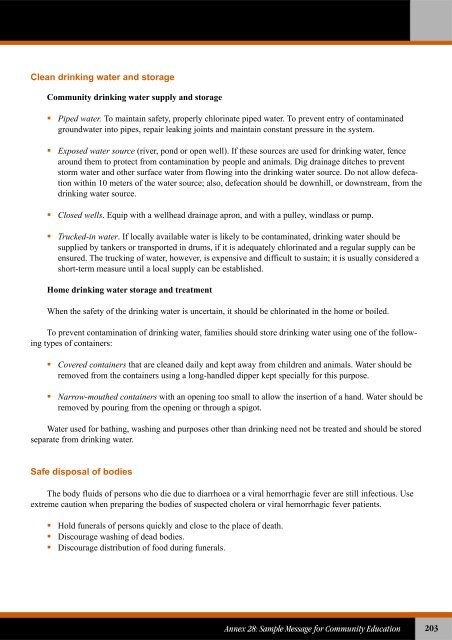Technical Guidelines for Integrated Disease Surveillance ... - PHRplus
Technical Guidelines for Integrated Disease Surveillance ... - PHRplus
Technical Guidelines for Integrated Disease Surveillance ... - PHRplus
Create successful ePaper yourself
Turn your PDF publications into a flip-book with our unique Google optimized e-Paper software.
Clean drinking water and storageCommunity drinking water supply and storage Piped water. To maintain safety, properly chlorinate piped water. To prevent entry of contaminatedgroundwater into pipes, repair leaking joints and maintain constant pressure in the system. Exposed water source (river, pond or open well). If these sources are used <strong>for</strong> drinking water, fencearound them to protect from contamination by people and animals. Dig drainage ditches to preventstorm water and other surface water from flowing into the drinking water source. Do not allow defecationwithin 10 meters of the water source; also, defecation should be downhill, or downstream, from thedrinking water source. Closed wells. Equip with a wellhead drainage apron, and with a pulley, windlass or pump. Trucked-in water. If locally available water is likely to be contaminated, drinking water should besupplied by tankers or transported in drums, if it is adequately chlorinated and a regular supply can beensured. The trucking of water, however, is expensive and difficult to sustain; it is usually considered ashort-term measure until a local supply can be established.Home drinking water storage and treatmentWhen the safety of the drinking water is uncertain, it should be chlorinated in the home or boiled.To prevent contamination of drinking water, families should store drinking water using one of the followingtypes of containers: Covered containers that are cleaned daily and kept away from children and animals. Water should beremoved from the containers using a long-handled dipper kept specially <strong>for</strong> this purpose. Narrow-mouthed containers with an opening too small to allow the insertion of a hand. Water should beremoved by pouring from the opening or through a spigot.Water used <strong>for</strong> bathing, washing and purposes other than drinking need not be treated and should be storedseparate from drinking water.Safe disposal of bodiesThe body fluids of persons who die due to diarrhoea or a viral hemorrhagic fever are still infectious. Useextreme caution when preparing the bodies of suspected cholera or viral hemorrhagic fever patients. Hold funerals of persons quickly and close to the place of death. Discourage washing of dead bodies. Discourage distribution of food during funerals.Annex 28: Sample Message <strong>for</strong> Community Education203















